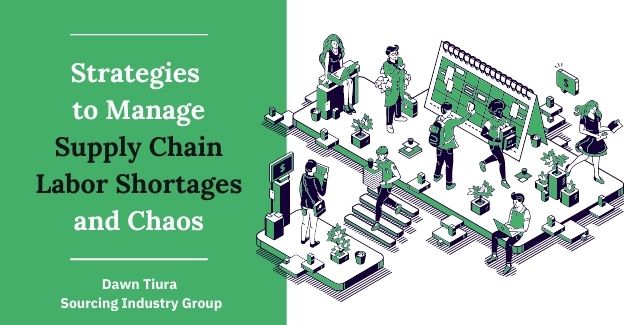The best way to survive the labor shortages is to ensure top talent is happy, says SIG CEO and President Dawn Tiura, CSP, CSMP, C3PRMP, CIAP.
Supply chain disruptions continue to drive up prices and lead to a growing shortage of goods across the U.S. and abroad. The Biden Administration has taken many steps over the last few months to address these issues and strengthen the country’s supply chain operations – e.g., creating the supply chain disruptions task force, calling on the National Guard to help ease the stress of disruptions, and extending port hours at the Port of Los Angeles.
But these proposed solutions, as well-intended as they are, may not be enough to ease the backlog on their own.
The real issue isn’t just the delay in dockings and unloading containers. The truck driver labor shortage is having a serious impact on the supply chains’ ability to operate properly. Over half of all freight shipped in the U.S. travels over the highways. A shortage of drivers leads to shipping delays, extended lead times, and problematic overhead. And it doesn’t appear the issue is going away any time soon. According to the American Trucking Association, the U.S. needs to recruit nearly 1 million truck drivers to replace retiring ones and keep up with high freight demand over the next decade.
It’s not only truckers. The Labor Department in July reported that the warehouse industry had a record 490,000 job openings. Companies such as Walmart, Target and Amazon are going to great lengths to attract warehouse workers with benefits, including free college tuition.
Looking Past Hiring
But hiring is just half the battle. Once hired, companies need to retain their workers. Many warehouse employees worked in industries designated as essential during the pandemic. They felt pressured to work despite an environment they felt was unsafe. As a result, the warehouse industry has cycled through millions of workers, some of whom have sworn off warehouse jobs altogether.
And even if warehouses are lucky enough to hire new workers, ARC Advisory Group research shows only 29% of warehouses can bring a new worker up to speed in less than a month (i.e., able to work at the average speed of all employees at that site). This timeline doesn’t help alleviate logistical nightmares with the busy holiday season.
Moreover, workers are using this crisis to demand raises and to negotiate better terms. Forty percent of all port traffic comes in through the west coast. Union dockworkers there are set to renegotiate their labor agreement in July of 2022, which is bound to create a work stoppage that further strangles port traffic. The contracts apply to about 15,000 ILWU members, including longshore workers, marine clerks, and foremen employed at 29 west coast ports, from Washington state’s northernmost port of Bellingham to San Diego (near the border with Mexico).
One constant remains amid all the uncertainty: Supply chain disruptions are going to continue well into 2022. Consider these strategies to help alleviate some of the pressures that continue to plague the industry.
Prioritize Talent
Supply chains need professionals in procurement organizations to traverse these murky waters. The best way to survive the labor shortages is to ensure top talent is happy. Companies need to use this urgency to digitize their operations with sophisticated tools. Technologies like AI don’t replace workers. Rather, it frees workers from wasting valuable time and resources on monotonous tasks that can be automated and empowers them to do more strategic, fulfilling work. Workers will jump at the opportunity to do challenging work. And if they’re not being challenged enough at their current workplaces, they will leave to pursue the opportunity elsewhere.
Become the “Customer-of-Choice”
To add some resiliency to supply chains, companies need to become the “customer-of-choice”. This means working with their suppliers to really understand their supply chain issues. For example, don’t penalize a supplier for missing a KPI (like on-time delivery, order fill rates, etc.). Instead, collaborate and come together with mutual trust and support for one another. By doing so, “customer-of-choice” companies are better positioned to keep their supply flowing.
Rethink Inventory Channels
Near zero inventory level and just-in-time delivery is not going to work. Although the cost of capital is still low, treasury departments don’t want to carry the cost of inventory. Companies must accept that inventory on-hand is a stopgap to carry them through current supply chain disruptions.
In the meantime, companies can solidify their relationships with each other. For example, the CPO at The University of California, San Francisco recounted how trust in partnerships helped his staff immensely when they were short on PPE during the early days of the pandemic. Salesforce oversaw that the university got the PPE they needed through its own network and delivered it directly via airplane from the manufacturers. This kept the medical and hospital systems running during a time of high uncertainty.
Invest in Infrastructure
Any long-term supply chain solution requires investment in the national infrastructure. For example, the government should consider implementing a COVID transportation law that is consistent across all 50 states. The Department of Transportation sets rules at a national level, but then individual states add nuances that make trucking even more complicated. This means that every time a trucker moves into a new city or state, new rules apply to them. For example, can they leave the vehicle; can they unload their own vehicle, or do they have to remain inside at loading docks; do they need masks and/or vaccinations; how long can they drive? The list goes on. A national law would standardize these rules and regulations for all states, eliminating guesswork and confusion from a trucker’s daily job.
Reframe Global Regulations
Global regulations are needed to protect both a company’s ability to import as well as to export. For example, ships should not be allowed to bypass being reloaded once empty. They should not be allowed to miss pickup deadlines so they can secure a good spot in line for advantageous fees. These issues and more need to be coordinated. Rules need to be rewritten. But it is going to take a number of countries and private businesses to align on common goals, standards and practices. And they have good reason to: Profits will be impacted, prices will be impacted, warehouses will be built, and goods will be transported once again in a timely manner.
Supply chain chaos will inevitably continue as we enter 2022. But the industry is no stranger to disruptions. The worker shortage won’t last forever, and the industry will align to operate on a global scale to better navigate challenges as they arise.
This article was first published in MH&L.









